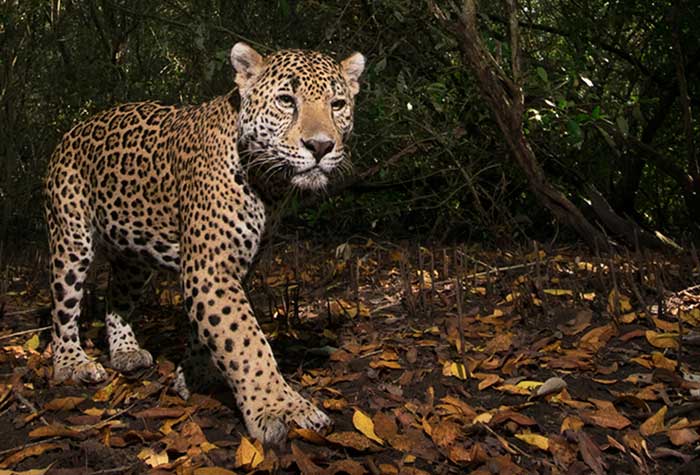|
By John Pint
Alejandro
Prieto is a prize-winning nature photographer whose pictures have
graced the pages of internationally known magazines like National
Geographic and BBC Wildlife Magazine. When I learned that
Prieto had recently completed a year-long
project to photograph the Mexican jaguar in its natural environment, I
wondered how he had managed to it, since few people have ever seen this
great cat in the wild. Fortunately, I was able to interview him in his
home high among the hills of Guadalajara, Mexico.

A
jaguar is captured facing the camera. Says photographer Alejandro
Prieto: “It’s essential to recognize the animal’s trail and catch it in
a natural pose. If I had put food on the ground, the picture would have
turned out very differently.” Photo by Alejandro Prieto.
“Tell me something about
Mexican jaguars,” I asked him.
“A
few years ago,” said Prieto, “Jaguar experts from all over the Republic
got together to estimate how many of these animals can still be found
in the country. They monitored areas in every state, using camera traps
placed at regular intervals and came to the conclusion that in 2011
there were less than 4,000 left in Mexico. This is down from an
estimated 20,000 at the beginning of the 20th century.”
Prieto
told me that most of Mexico’s jaguars are in the south, in Campeche and
Chiapas, but that this animal is very adaptable and does well in
different ecosystems. “For example,” said the photographer, “they do
well in Manantlán, which is all pines and oaks at a high altitude, but
they also live in mangrove swamps, in the desert and in the Chiapaneca
Jungle, which is totally different from these other environments. The
ones that live in the mangroves spend practically all their time in the
water and principally live on fish, while those in Manantlán eat deer
and boars.”
As to why the number of such adaptable creatures is
plummeting so drastically, Prieto says the biggest problem is their
loss of territory, due to deforestation. Next come problems caused by
poachers. They either go after the jaguar itself or after their prey,
such as deer, raccoons, badgers and boars. Without sufficient prey, the
jaguars start to hunt cattle and trouble develops with cattle ranchers
who often respond by putting out poison. Says Prieto, “If a jaguar
brings down a cow, it doesn’t eat it all at once. It comes back a few
days later to finish the meal. This makes it easy for the vaqueros to
poison the carcass or to set traps. So it’s a vicious circle: people
kill the jaguar’s prey; without prey the jaguar kills cattle; then
people kill the jaguar. This creates a serious problem.”
Alejandro
Prieto is working with a foundation called Alianza Jaguar, which is
trying to solve the problems mentioned above. Prieto’s job is to get
first-class photographs of jaguars in their natural environment for
promotional purposes. “Jaguars are almost never seen in the wild,”
Prieto told me, “so I use very special camera traps to get the pictures
I need. These are not the typical cameras that conservationists attach
to a tree. I use a professional camera inside a housing I especially
make for it. Then I have four external flashes, each one protected by a
tube, and finally infrared sensors that trigger the shutter when the
animal passes a pre-chosen spot. It’s a sort of self-operating photo
studio in the middle of nowhere.”
Numerous visits to jaguar
habitats with experienced guides helped Prieto learn to recognize this
cat’s trails. Still, luck plays a big part in the process. “Sometimes
you don’t get what you were planning for,” he says with a smile.
“Instead you get a deer or a puma or a wild boar. I have thousands of
pictures like that!”
He showed me a gorgeous
picture of a jaguar
scratching a tree trunk, taken from high in the tree. “This picture
turned out great,” he told me, “but it took me eight months to get it!”
This may explain why Prieto is presently the only professional
photographer in Mexico using this particular technique.
“Have you ever seen a jaguar in the wild with your own eyes?” I asked
him.
“I
have been lucky,” he replied. I saw two on the same day. I was in Las
Marismas Nacionales, a swampy area between San Blas and Mazatlán, where
there are nothing but mangroves, which support a population of about 30
jaguars. It was around sunset and I was walking along a trail to the
spot where I wanted to put a camera, and the jaguar was coming down the
same path the other way—and we almost collided. Both of us were equally
surprised and then the jaguar jumped off the trail and into the
mangroves. I even managed to snap a picture, but with my cell phone.
Then, that very same night, I saw another one. I was with a local man
who said he had never before seen a jaguar with his own eyes during his
entire life.”
If you don’t feel like spending the rest of your
life wandering remote trails to spot a jaguar, you might want to visit
alejandroprietophotography.com. Go to “Stories” and click on any of the
photos to open an album of marvelous nature photographs. You won’t
regret it! If you want to know more about Alianza Jaguar’s work, go to
alianzajaguar.org, scroll down to the bottom of the page and click on
English.
By the way, Alejandro Prieto’s latest photographic
project is tracking the elusive axolotl or “Mexican Walking Fish.” I
hope to report on what he has found in an upcoming article.
|

